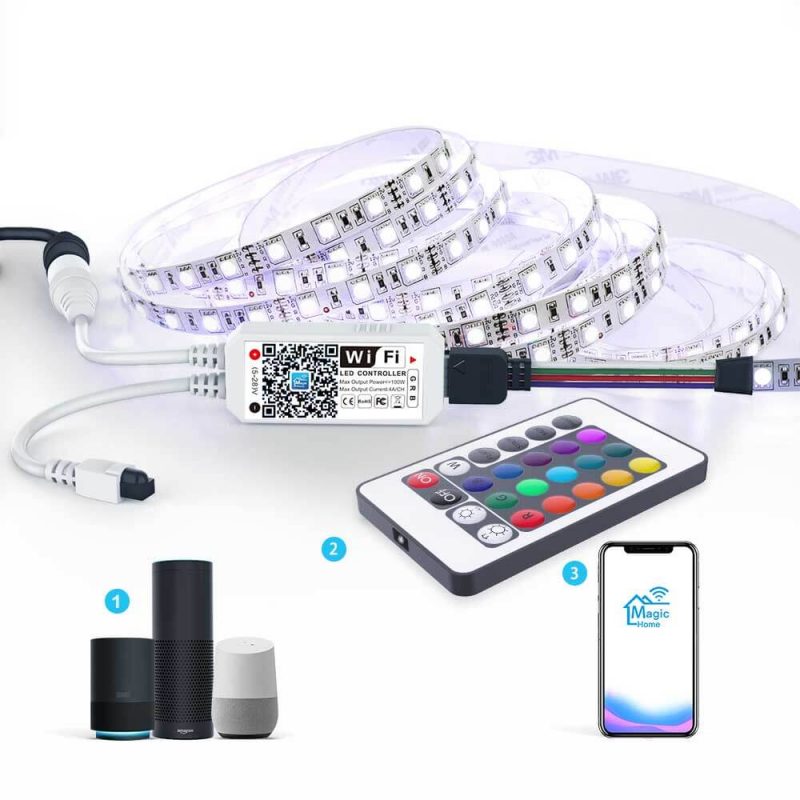In recent years, LED strip lights have emerged as innovative tools, revolutionizing the world of lighting. From home decor to stage design and park illuminations, these versatile fixtures have left their glowing imprint. But what truly supercharged their functionality and triggered the growth of the smart lighting industry? Enter the small yet mighty LED controller.

Table of Contents
ToggleA New Dawn in Lighting: The Rise of LED Strips
As an evolutionary leap in lighting technology, LED strips have captivated countless enthusiasts. The advent of smart technology infused a new dimension into these strips, opening up a vast playground of intelligent, decorative lighting.
The Heart of Smart Lighting: Understanding the LED Controller
An LED controller, a compact yet potent device, serves as the brain that transforms a traditional light strip into a smart one. It does this seamlessly, without any alterations to the strip itself, bolstering the advancement of the smart lighting industry.
Naturally, the effectiveness of this transformation depends on the technical solutions deployed by different LED controllers.
The Building Blocks of an LED Controller
At its core, an LED controller houses a microcontroller (MCU) or a digital signal processor (DSP) chip. These are surrounded by peripheral analog and digital electronic circuits.
Software programs written for these hardware components enable them to govern a range of electronic components as per specific needs and functionalities.
Diverse Paths to Connectivity: The Different Types of LED Controllers
Today’s market showcases a plethora of LED controllers, each offering unique connectivity options. These include:
- Wifi LED controllers
- Bluetooth LED controllers
- Zigbee LED controllers
Harnessing the Power of LED Controllers: Key Features and Functions
When an LED controller connects to strip lights, it unlocks a spectrum of impressive features:
- Universal Compatibility: These devices support both Apple and Android smartphones, enabling WiFi or Bluetooth control.
- Color Versatility: With control over 16 million colors, users can adjust both brightness and color temperature.
- Personalized Dynamic Mode: LED controllers offer the freedom to customize color, sequence, speed, and various effects such as fading and strobing, tailoring to the ambiance of different scenes.
- Group Control: By forming groups, one can control multiple strips at once, with each group supporting up to 64 strips.
- Timer Function: These devices allow automatic switching of lights or color/function/temperature adjustments within specified times.
- Music Synchronization: Users can select songs to play on their smartphones, and the lights will rhythmically pulse in response.
- Camera Color Matching: With a camera function, LED controllers can mirror the colors of the phone camera’s view.
The Impact of LED Controllers on Traditional Light Strips
Connected to an LED controller, traditional light strips transcend into smart, responsive lighting solutions. With their computing power and network connectivity, LED controllers can interface with specialized apps on phones, continually expanding their functions.
Their core functions go beyond simple control and light effects. LED controllers foster creativity, promote sharing, enable light-music interactions, and even contribute to overall wellness and happiness.
Global Control: Your Lights, Your Rules
Regardless of your geographical location, with network access, you can rule over your lights. Be it changing colors, flipping the switch, adjusting brightness, or setting a timer – all can be done using your smartphone. That’s the magic of LED controllers – they make your life smarter.
Conclusion
In essence, an LED controller is the bridge that connects traditional lighting to the realm of smart technology. By offering diverse functionalities and effortless control, it has revolutionized the way we perceive and interact with light. Whether you’re illuminating your home or setting a mood, the LED controller is your personalized wizard of light.
FAQs
- What is an LED controller?
An LED controller is a device that enables you to adjust and personalize the various features of your LED strip lights, including color, brightness, sequence, and more. - What are the different types of LED controllers?
LED controllers vary by their connectivity options, which can include WiFi, Bluetooth, or Zigbee. - Can I control multiple LED strip lights at once with an LED controller?
Yes, by utilizing the group function on an LED controller, you can control up to 64 LED strip lights at the same time. - Can I control my lights from anywhere with an LED controller?
Yes, as long as you have network connectivity, you can control your lights from anywhere in the world through your smartphone. - How do LED controllers improve the functionality of traditional light strips?
LED controllers turn traditional light strips into smart lights, adding functionalities like remote control, color and brightness adjustment, timer setting, music synchronization, and more.
